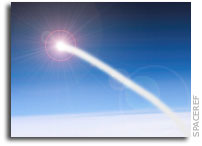NASA Selects Experimental Commercial Suborbital Flight Payloads

NASA’s Flight Opportunities Program has selected 13 cutting-edge space technology payloads for flights on commercial reusable launch vehicles, balloons and a commercial parabolic aircraft in 2013 and 2014. The flights will allow participants to demonstrate their technologies to the edge of space and back, before committing them to the harsh and unforgiving conditions of spaceflight.
The vehicles that will carry these payloads will include Las Vegas-based Zero-G Corporation’s parabolic airplane and high altitude balloons from Near Space Corp. in Tillamook, Ore. They also will include reusable launch vehicles from Masten Space Systems in Mojave, Calif.; UP Aerospace in Highlands Ranch, Colo.; and Virgin Galactic in Las Cruces, N.M.
“These payloads represent more real progress in our goal of fostering a viable market for American commercial reusable suborbital platforms — access to near space that provides the innovation needed for cutting-edge space technology research and development,” said Michael Gazarik, director of NASA’s Space Technology Program. “American leadership in the commercial suborbital flight market will prove to benefit technology development across NASA, universities, industries and in our new technology economy.”
A wide range of innovative payloads are represented in this selection. The Resonant Inductive Near-field Generation System payload from the University of Maryland in College Park will use the parabolic flights to perform preliminary tests on a technology that seeks to hold a cluster of satellites in formation using magnetic fields.
A payload from Astrobotic Technology Inc. of Pittsburgh will be tested on a suborbital reusable launch vehicle that takes off and lands vertically. The demonstration will examine how the company’s automated landing system may enable future unmanned missions to land on another planet or the rocky and hazardous terrain of an asteroid.
Nine of the selected payloads will fly on parabolic aircraft flights, which provide brief periods of weightlessness. Four will fly on suborbital reusable launch vehicles. Two will be carried on high-altitude balloons that fly to 100,000 feet. One will fly on a vertical launch and landing suborbital vehicle. One payload will fly on both a suborbital launch vehicle and a high-altitude balloon.
The selected payloads, listed with their principal investigators, are:
Flight on a parabolic aircraft:
— “Structural Dynamics Test of STACER Antenna Deployment in Microgravity,” Kerri Cahoy of Massachusetts Institute of Technology in Cambridge
— “UAH ChargerSat-2 Parabolic Flight Testing,” Francis Wessling of the University of Alabama in Huntsville
— “High Eccentric Resistive Overload (HERO) Device Demonstration during Parabolic Flight,” Aaron Weaver of NASA’s Glenn Research Center in Cleveland
— “Assessing Otolith-Organ Function with Vestibular Evoked Myogenic Potentials (VEMPs) in Parabolic Flight,” Mark Shelhamer of Johns Hopkins University School of Medicine in Baltimore
— “On the Performance of a Nanocatalyst-based Direct Ammonia Alkaline Fuel Cell (DAAFC) under Microgravity Conditions for Water Reclamation and Energy Applications,” Carlos Cabrera of the University of Puerto Rico in San Juan
— “Dynamic and Static Behavior of a Flexible Fuel Hose in Zero-G,” Allyson Buker of Jackson and Tull in Washington
— “In-Flight Lab Analysis Technology Demonstration in Reduced Gravity,” Emily Nelson of Glenn
— “Caging System for Drag-free Satellites,” Robert Byer of Stanford University in California
— “Reduced Gravity Flight Demonstration of the Resonant Inductive Near-field Generation System,” Raymond Sedwick of the University of Maryland in College Park
Flight on a vertical launch and landing suborbital vehicle:
— “Autolanding for Robotic Precursor Missions,” Kevin Peterson of Astrobotic Technology Inc. in Pittsburgh
Flight on a high altitude balloon:
— “Deployable Rigid Adjustable Guided Final Landing Approach Pinions,” Jonathan Powers of Masten Space Systems Inc. in Mojave, Calif.
— “Guided Parafoil High Altitude Research,” Allen Lowry of Airborne Systems North America of CA Inc. in Santa Ana, Calif.
Flights on multiple platforms:
— “Flight Testing of a UAT ADS-B Transmitter Prototype for Commercial Space Transportation Using Reusable Launch Vehicles,” Richard Stansbury of Embry-Riddle Aeronautical University in Daytona Beach, Fla.
NASA manages the Flight Opportunities Program manifest, matching payloads with flights, and will pay for payload integration and the flight costs for the selected payloads. No funds are provided for the development of these payloads.
NASA’s Dryden Flight Research Center in Edwards, Calif., manages the Flight Opportunities Program for NASA’s Space Technology Program in Washington. NASA’s Ames Research Center in Moffett Field, Calif., manages the payload activities for the program. NASA’s Space Technology Program is innovating, developing, testing and flying hardware for use in NASA’s future missions.
For more information on the Flight Opportunities program, visit: http://flightopportunities.nasa.gov








